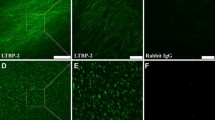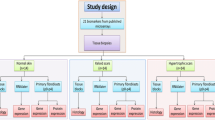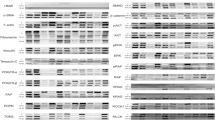Abstract
Elastofibroma is a rare tumour that occurs in the subscapular space, and it typically presents in middle-aged and older individuals. The aetiology of elastofibroma remains unknown. Recent, sporadic reports have shown, immunohistologically, that fibroblasts in elastofibroma may produce abnormal elastic and collagen fibres through the action of transforming growth factor-beta (TGF-β), a factor that promotes fibroblast proliferation. However, that finding lacked quantitative measurements and controls. Therefore, in this study, we performed quantitative, immunohistochemical analyses of TGF-β1 and basic fibroblast growth factor (bFGF) in three elastofibromas, and we compared them to ten dermatofibromas and keloids, and five normal skin. In elastofibroma specimens, 16–59 % fibroblasts were positive for TGF-β1 in the cytoplasm, compared to 96 % in dermatofibroma, 93 % in keloid and 2 % in normal dermis specimens. Also, in elastofibroma specimens, 26–67 % of fibroblasts were positive for bFGF in the cytoplasm, compared to 97 % in dermatofibroma, 97 % in keloid, and 22 % in normal dermis specimens. Intriguingly, the tumour size and growth rate were proportional to the percentage of cells positive for bFGF. Finally, greater levels of bFGF expressions in fibroblasts were associated with larger sized elastofibromas. These results suggested that elastofibroma development depended on high expression of TGF-β1 and bFGF.




Similar content being viewed by others
References
Jarvi O, Saxen E (1961) Elastofibroma dorse. Acta Pathol Microbiol Scand Suppl 51(Suppl 144):83–84
Daigeler A, Vogt PM, Busch K, Pennekamp W, Weyhe D, Lehnhardt M, Steinstraesser L, Steinau HU, Kuhnen C (2007) Elastofibroma dorsi-differential diagnosis in chest wall tumours. World J Surg Oncol 5:15
Kumaratilake JS, Krishnan R, Lomax-Smith J, Cleary EG (1991) Elastofibroma: disturbed elastic fibrillogenesis by periosteal-derived cells? An immunoelectron microscopic and in situ hybridization study. Hum Pathol 22:1017–1029
Beer TW, Lam MH, Heenan PJ (2009) Elastofibroma dorsi (Elastofibroma). In: Lever’s histopathology of the skin, tenth edition. Lippincott Williams & Wilkins, Philadelphia, p 987
Nishio JN, Iwasaki H, Ohjimi Y, Ishiguro M, Koga T, Isayama T, Naito M, Kikuchi M (2002) Gain of Xq detected by comparative genomic hybridization in elastofibroma. Int J Mol Med 10:277–280
Hernandez JL, Rodriguez-Parets JO, Valero JM, Munoz MA, Benito MR, Hernandez JM, Bullon A (2010) High-resolution genome-wide analysis of chromosomal alterations in elastofibroma. Virchows Arch 456:681–687
Kuroda N, Hamaguchi N, Ohara M, Hirouchi T, Mizuno K, Hayashi Y, Lee GH (2008) Elastofibroma: a histochemical, immunohistochemical, and ultrastructural study of two patients. Med Mol Morphol 41:179–182
Shi Y, Massague J (2003) Mechanisms of TGF-beta signaling from cell membrane to the nucleus. Cell 113:685–700
Ikushima H, Komuro A, Isogaya K, Shinozaki M, Hellman U, Miyazawa K, Miyazono K (2008) An Id-like molecule, HHM, is a synexpression group-restricted regulator of TGF-beta signalling. EMBO J 27:2955–2965
Border WA, Noble NA (1994) Transforming growth factor beta in tissue fibrosis. N Engl J Me 331:1286–1292
Bikfalvi A, Klein S, Pintucci G, Rifkin DB (1997) Biological roles of fibroblast growth factor-2. Endocr Rev 18:26–45
Author information
Authors and Affiliations
Corresponding author
Ethics declarations
Conflict of interest
None.
Funding sources that supported the work
None.
Rights and permissions
About this article
Cite this article
Imanishi, A., Imanishi, H., Yoshida, Y. et al. Upregulation of TGF-β1 and basic FGF in elastofibroma: an immunohistochemical analysis. Med Mol Morphol 49, 83–88 (2016). https://doi.org/10.1007/s00795-015-0126-z
Received:
Accepted:
Published:
Issue Date:
DOI: https://doi.org/10.1007/s00795-015-0126-z




